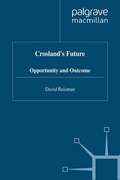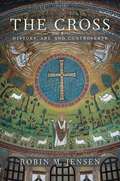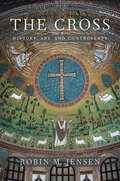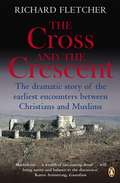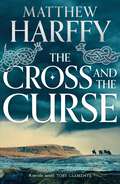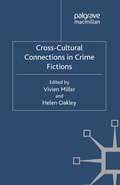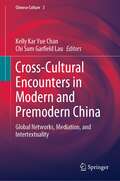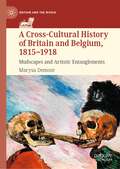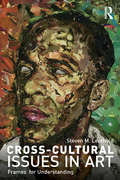- Table View
- List View
Crosland's Future: Opportunity and Outcome
by D. ReismanAnthony Crosland, a member of Harold Wilson's cabinet and the author of The Future of Socialism, was immensely influential in seeking to modernise the ideology of the Labour Party, to put opportunity and empowerment, the fairness of life chances and the sharing of social experiences at its centre in place of nationalisation. The party's belated redefinition guarantees a prominent role in its intellectual history to the revisionists' champion. Though Crosland wrote when economic growth could be taken for granted as the basis for social reform, his emphasis on fairness and community, on education and opportunity, continues to illuminate political debate in harder times.
The Cross: History, Art, and Controversy
by Robin M. JensenThe cross stirs intense feelings among Christians and non-Christians alike. Robin Jensen takes readers on an intellectual and spiritual journey through the 2,000-year evolution of the cross as idea and artifact, illuminating the controversies and forms of devotion this central symbol of Christianity inspires.
The Cross: History, Art, and Controversy
by Robin M. JensenThe cross stirs intense feelings among Christians and non-Christians alike. Robin Jensen takes readers on an intellectual and spiritual journey through the 2,000-year evolution of the cross as idea and artifact, illuminating the controversies and forms of devotion this central symbol of Christianity inspires.
Cross and Scepter: The Rise of the Scandinavian Kingdoms from the Vikings to the Reformation
by Sverre BaggeChristianity and European-style monarchy—the cross and the scepter—were introduced to Scandinavia in the tenth century, a development that was to have profound implications for all of Europe. Cross and Scepter is a concise history of the Scandinavian kingdoms from the age of the Vikings to the Reformation, written by Scandinavia's leading medieval historian. Sverre Bagge shows how the rise of the three kingdoms not only changed the face of Scandinavia, but also helped make the territorial state the standard political unit in Western Europe. He describes Scandinavia’s momentous conversion to Christianity and the creation of church and monarchy there, and traces how these events transformed Scandinavian law and justice, military and administrative organization, social structure, political culture, and the division of power among the king, aristocracy, and common people. Bagge sheds important new light on the reception of Christianity and European learning in Scandinavia, and on Scandinavian history writing, philosophy, political thought, and courtly culture. He looks at the reception of European impulses and their adaptation to Scandinavian conditions, and examines the relationship of the three kingdoms to each other and the rest of Europe, paying special attention to the inter-Scandinavian unions and their consequences for the concept of government and the division of power.Cross and Scepter provides an essential introduction to Scandinavian medieval history for scholars and general readers alike, offering vital new insights into state formation and cultural change in Europe.
Cross and Scepter: The Rise of the Scandinavian Kingdoms from the Vikings to the Reformation (PDF)
by Sverre BaggeChristianity and European-style monarchy—the cross and the scepter—were introduced to Scandinavia in the tenth century, a development that was to have profound implications for all of Europe. Cross and Scepter is a concise history of the Scandinavian kingdoms from the age of the Vikings to the Reformation, written by Scandinavia's leading medieval historian. Sverre Bagge shows how the rise of the three kingdoms not only changed the face of Scandinavia, but also helped make the territorial state the standard political unit in Western Europe. He describes Scandinavia’s momentous conversion to Christianity and the creation of church and monarchy there, and traces how these events transformed Scandinavian law and justice, military and administrative organization, social structure, political culture, and the division of power among the king, aristocracy, and common people. Bagge sheds important new light on the reception of Christianity and European learning in Scandinavia, and on Scandinavian history writing, philosophy, political thought, and courtly culture. He looks at the reception of European impulses and their adaptation to Scandinavian conditions, and examines the relationship of the three kingdoms to each other and the rest of Europe, paying special attention to the inter-Scandinavian unions and their consequences for the concept of government and the division of power.Cross and Scepter provides an essential introduction to Scandinavian medieval history for scholars and general readers alike, offering vital new insights into state formation and cultural change in Europe.
The Cross and the Crescent: The Dramatic Story of the Earliest Encounters Between Christians and Muslims (Universal History Ser.)
by Richard FletcherA short, brilliant account of the relations between Islam and Christianity from Muhammad to the Reformation. Fletcher argues that though there were trading and cultural interactions between Islam and Christianity during the period when Arabs controlled most of the Mediterranean world, neither side was remotely interested in the religion of the other. "Christian and Moslem lived side by side in a state of mutual religious aversion. Given these circumstances, if religious passions were to be stirred up, confrontation would probably be violent." He shows how religious misunderstanding and antagonism between "the peoples of the book" has been present since their earliest encounters.
The Cross and the Curse (The Bernicia Chronicles #2)
by Matthew HarffyAD 634. ANGLO SAXON BRITAIN. Confusion and conflict continue as warlords battle across Britain to become the first King of the English. After a stunning victory against the native Waelisc, Beobrand returns to a hero's welcome. His valour is rewarded by wealth and land by Oswald, King of Northumbria. Exhausted, he retires to his new estate with his bride only to find himself surrounded once again by enemies old and new. With treachery and death on all sides, Beobrand fears he will lose all he holds dear. On a quest for revenge and redemption, he accepts the mantle of lord, leading his men into the darkest of nights and the bloodiest of battles. The Cross and the Curse is the second gripping, action-packed instalment in The Bernicia Chronicles. 'Murder, betrayal and vengeance fuel tribal warfare and personal combat. Beobrand is the warrior to follow' DAVID GILMAN.
Cross Country: English Buildings and Landscape From Countryside to Coast
by Peter AshleyIn Cross Country photographer and author Peter Ashley unleashes his passion for Blighty. He takes us on an enlightening jaunt that encompasses many of England’s most loved regions. His love of buildings and landscape extends far beyond architecture in picturesque surroundings. By combining personal reminiscence and an ear for intriguing anecdote, he shows us with wit, and sometimes irreverent comment, just how richly varied the fabric of England is: abandoned Cornish tin mines above tide-washed caves; Norfolk boat sheds leaning on salt marches; Romney Marsh shepherd’s houses disappearing behind roadside willows; and hedges looked over in Wiltshire. Local details are found in both Essex estuaries and Cumbrian sand dunes; and long abandoned railway lines are once again pressed into service to take us around his beloved High Leicestershire. Ashley never misses the curious and neglected – be it a sheep wash in the Cotswolds or a disused petrol pump in Herefordshire. He travels deep into t eh countryside he cares about. His wry observations allow us to rediscover and delight in what many of us might previously have deemed familiar territory.
Cross-Cultural Connections in Crime Fictions
by Vivien Miller and Helen OakleyA collection of ten original essays forging new interdisciplinary connections between crime fiction and film, encompassing British, Swedish, American and Canadian contexts. The authors explore representations of race, gender, sexuality and memory, and challenge traditional categorisations of academic and professional crime writing.
Cross-Cultural Counseling: The Arab-Palestinian Case
by Frank De PianoAs a therapist, you may find yourself at a brick wall when you try to treat Middle Eastern, North African, South American, Asian, and other clients with psychotherapeutic techniques formulated in the West. As Cross-Cultural Counseling: The Arab-Palestinian Case illustrates, the construction of self, community, and society is remarkably different in Arab countries. Only certain aspects of Western psychotherapy can be adapted to respond to the unique sociopolitical conditions and cultural factors affecting the mental health of people raised to consider community needs over self needs and desires. This text suggests a biopsychosocial approach to treating psychological disorders among Arab clients and highlights differences in the prevalence and manifestation of psychological disorders among peoples of South/Eastern backgrounds, as compared to what is known in the West. You’ll gain an education and understanding from Cross-Cultural Counseling that helps you provide more effective services to Arabs and Palestinians to meet their mental health needs. Cross-Cultural Counseling shows you how divesting therapeutic techniques of cultural sensitivity results in the alienation of clients who are not accustomed to recognizing or meeting their individual needs. It suggests a biopsychosocial approach to treating psychological disorders among Arab clients and highlights differences in the prevalence and manifestation of psychological disorders among peoples of South/Eastern backgrounds, as compared to what is known in the West. Challenging therapists to discard their misconceptions and biases about people who don’t fit the Western mold in terms of individualization, identity, and personality, the book also covers: different sociopolitical situations in Arab countries and the maintenance of authoritarian and collectivistic culture psychocultural features of Arabs socialization in Arab homes and schools help-seeking behavior among Arabs and poor mental health service delivery in Arab countries factors threatening the unity of the Palestinian family therapeutic recommendations for traditional clientsAccording to author Marwan Dwairy, Cross-Cultural Counseling is meant to “undo the dehumanization that has surrounded Palestinian-Arabs and help clinicians to understand the behavior of the Arab client and come to know the person in him or her.” Certainly, no other book can help you, as a psychologist, psychiatrist, or mental health professional, treat Palestinians, Arabs, and other South/Eastern clients as efficiently and successfully.
Cross-Cultural Counseling: The Arab-Palestinian Case
by Frank De PianoAs a therapist, you may find yourself at a brick wall when you try to treat Middle Eastern, North African, South American, Asian, and other clients with psychotherapeutic techniques formulated in the West. As Cross-Cultural Counseling: The Arab-Palestinian Case illustrates, the construction of self, community, and society is remarkably different in Arab countries. Only certain aspects of Western psychotherapy can be adapted to respond to the unique sociopolitical conditions and cultural factors affecting the mental health of people raised to consider community needs over self needs and desires. This text suggests a biopsychosocial approach to treating psychological disorders among Arab clients and highlights differences in the prevalence and manifestation of psychological disorders among peoples of South/Eastern backgrounds, as compared to what is known in the West. You’ll gain an education and understanding from Cross-Cultural Counseling that helps you provide more effective services to Arabs and Palestinians to meet their mental health needs. Cross-Cultural Counseling shows you how divesting therapeutic techniques of cultural sensitivity results in the alienation of clients who are not accustomed to recognizing or meeting their individual needs. It suggests a biopsychosocial approach to treating psychological disorders among Arab clients and highlights differences in the prevalence and manifestation of psychological disorders among peoples of South/Eastern backgrounds, as compared to what is known in the West. Challenging therapists to discard their misconceptions and biases about people who don’t fit the Western mold in terms of individualization, identity, and personality, the book also covers: different sociopolitical situations in Arab countries and the maintenance of authoritarian and collectivistic culture psychocultural features of Arabs socialization in Arab homes and schools help-seeking behavior among Arabs and poor mental health service delivery in Arab countries factors threatening the unity of the Palestinian family therapeutic recommendations for traditional clientsAccording to author Marwan Dwairy, Cross-Cultural Counseling is meant to “undo the dehumanization that has surrounded Palestinian-Arabs and help clinicians to understand the behavior of the Arab client and come to know the person in him or her.” Certainly, no other book can help you, as a psychologist, psychiatrist, or mental health professional, treat Palestinians, Arabs, and other South/Eastern clients as efficiently and successfully.
Cross-Cultural Encounters and Conflicts (Studies in Middle Eastern History)
by Charles IssawiCharles Issawi's collection of essays, Cross-Cultural Encounters and Conflicts, has been written in the belief that a study of the past encounters and conflicts between the world's major cultures can shed light on their nature and importance. Though the emphasis is on the Middle East, of which Issawi is one of our foremost scholars, the subjects covered here range in scope from the great ancient civilizations to Shelley's passion for the Middle East, from the failures of the Greeks as empire builders to the preeminence of English as an international language today. Other essays examine either the way in which certain cultures were formed, or the effects of the direct control of one culture over another, or cross-cultural perceptions, most notably the dramatic change in the Western perception of the Orient between the eighteenth and nineteenth centuries. In this age of multiculturalism, conflicts between the world's cultures have become a dominant feature of the international landscape. This excellent collection is a much-needed exploration of their historical nature.
Cross-Cultural Encounters in Modern and Premodern China: Global Networks, Mediation, and Intertextuality (Chinese Culture #3)
by Kelly Kar Yue Chan Chi Sum Garfield LauThis book presents an essential contribution to approaches in the studies of film, literature, performance, translation, and other art forms within the Chinese cultural tradition, examining East-West cultural exchange and providing related intertextual dialogue. The assessment of cultural exchange in the East-West context involves the original source, the adapted text, and other enigmatic extras incurred during the process. It aims to evaluate the linkage among, but not limited to, literature, film, music, art, and performance. The sections unpack how canonical texts can be read anew in modern society; how ideas can be circulated around the world based on translation, adaptation, and reinvention; and how the global networks of circulation can facilitate cultural interaction and intervention. The authors engage discussions on longstanding debates and controversies relating to Chinese literature as world literature; reconciliations of cultural identity under the contemporary waves of globalization and glocalization; Chinese-Western film adaptations and their impact upon cinematic experiences; an understanding of gendered roles and voices under the social gaze; and the translation of texts from intertextual angles. An enriching intellectual, intertextual resource for researchers and students enthusiastic about the adaptation and transformation process of different genres, this book is a must-have for Sinophiles. It will appeal to world historians interested in the global networks of connectivity, scholars researching cultural life in East Asia, and China specialists interested in cultural studies, translation, and film, media and literary studies.
Cross-Cultural Encounters in Modern World History
by Jon T. Davidann Marc Jason GilbertCross-Cultural Encounters in Modern World History explores cultural contact as an agent of change. It takes an encounters approach to world history since 1500, rather than a political one, to reveal different perspectives and experiences as well as key patterns and transformations. It studies the spaces between cultures historically to help us transcend human differences today in a rapidly globalizing world. The text focuses on first encounters that suggest long-term developments and particularly significant encounters that have changed the direction of world history. Because of the complexities of these encounters, the author takes a user-friendly approach to keep the text accessible to students with varying backgrounds in history.
Cross-Cultural Encounters in Modern World History
by Jon T. Davidann Marc Jason GilbertCross-Cultural Encounters in Modern World History explores cultural contact as an agent of change. It takes an encounters approach to world history since 1500, rather than a political one, to reveal different perspectives and experiences as well as key patterns and transformations. It studies the spaces between cultures historically to help us transcend human differences today in a rapidly globalizing world. The text focuses on first encounters that suggest long-term developments and particularly significant encounters that have changed the direction of world history. Because of the complexities of these encounters, the author takes a user-friendly approach to keep the text accessible to students with varying backgrounds in history.
Cross-Cultural Encounters in Modern World History, 1453-Present
by Jon Davidann Marc Jason GilbertOne of the hallmarks of world history is the ever-increasing ability of humans to cross cultural boundaries. Taking an encounters approach that opens up history to different perspectives and experiences, Cross-Cultural Encounters in Modern World History examines cultural contact between people from across the globe between 1453 and the present. The book examines the historical record of these contacts, distilling from those processes patterns of interaction, different peoples’ perspectives, and the ways these encounters tended to subvert the commonly accepted assumptions about differences between peoples in terms of race, ethnicity, nationhood, or empire. This new edition has been updated to employ current scholarship and address recent developments, as well as increasing the treatment of indigenous agency, including the major role played by Polynesians in the spread of Christianity in Oceania. The final chapter has been updated to reflect the refugee crisis and the evolving political situation in Europe concerning its immigrant population. Supported by engaging discussion questions and enlivened with the voices and views of those who were and remain directly engaged in the process of cross-cultural exchange, this highly accessible volume remains a valuable resource for all students of world history.
Cross-Cultural Encounters in Modern World History, 1453-Present
by Jon T Davidann Marc Jason GilbertOne of the hallmarks of world history is the ever-increasing ability of humans to cross cultural boundaries. Taking an encounters approach that opens up history to different perspectives and experiences, Cross-Cultural Encounters in Modern World History examines cultural contact between people from across the globe between 1453 and the present. The book examines the historical record of these contacts, distilling from those processes patterns of interaction, different peoples’ perspectives, and the ways these encounters tended to subvert the commonly accepted assumptions about differences between peoples in terms of race, ethnicity, nationhood, or empire. This new edition has been updated to employ current scholarship and address recent developments, as well as increasing the treatment of indigenous agency, including the major role played by Polynesians in the spread of Christianity in Oceania. The final chapter has been updated to reflect the refugee crisis and the evolving political situation in Europe concerning its immigrant population. Supported by engaging discussion questions and enlivened with the voices and views of those who were and remain directly engaged in the process of cross-cultural exchange, this highly accessible volume remains a valuable resource for all students of world history.
Cross-Cultural History and the Domestication of Otherness
by Michal Jan Rozbicki and George O. NdegeThis book illuminates our understanding of what happens when different cultures meet. Twelve cultural historians explore the mechanism and inner dynamic of such encounters, and demonstrate that while they often occur on the wave of global forces and influences, they only acquire meaning locally, where culture inherently resides.
A Cross-Cultural History of Britain and Belgium, 1815–1918: Mudscapes and Artistic Entanglements (Britain and the World)
by Marysa DemoorThis book highlights the ways in which Britain and Belgium became culturally entangled as a result of their interaction in the period between the Napoleonic Wars and the First World War. In the course of the nineteenth century, the battlefields of Waterloo and Ypres in Belgium became veritable burial grounds for generations of dead British military, indirectly leading to the most intensive ties between the two countries. By exploring this twofold path, the author uncovers a series of cross-influences and creative similarities within the Belgo-British artistic community, and explores the background against which the British national identity was constructed. Revealing unknown links between some of the most famous artists on both sides of the channel, such as D.G. Rossetti and Jan Van Eyck; Christina Rossetti and Fernand Khnopff; John Millais and Pieter Breughel, and Lewis Carroll and Quentin Massys, the book emphasises an artistic cross-fertilisation that can be found within battlefield literature throughout the nineteenth century, including examples from the likes of William M. Thackeray, Frances Trollope and Charlotte Brontë. Providing a rich intercultural history of Belgo-British relations after the battle of Waterloo, this interdisciplinary book will appeal to scholars and students researching history, literature, art and cultural studies.
Cross-Cultural Interaction Between Byzantium and the West, 1204–1669: Whose Mediterranean Is It Anyway? (Publications of the Society for the Promotion of Byzantine Studies #22)
by Angeliki LymberopoulouThe early modern Mediterranean was an area where many different rich cultural traditions came in contact with each other, and were often forced to co-exist, frequently learning to reap the benefits of co-operation. Orthodox, Roman Catholics, Muslims, Jews, and their interactions all contributed significantly to the cultural development of modern Europe. The aim of this volume is to address, explore, re-examine and re-interpret one specific aspect of this cross-cultural interaction in the Mediterranean – that between the Byzantine East and the (mainly Italian) West. The investigation of this interaction has become increasingly popular in the past few decades, not least due to the relevance it has for cultural exchanges in our present-day society. The starting point is provided by the fall of Constantinople to the troops of the Fourth Crusade in 1204. In the aftermath of the fall, a number of Byzantine territories came under prolonged Latin occupation, an occupation that forced Greeks and Latins to adapt their life socially and religiously to the new status quo. Venetian Crete developed one of the most fertile ‘bi-cultural’ societies, which evolved over 458 years. Its fall to the Ottoman Turks in 1669 marked the end of an era and was hence chosen as the end point for the conference. By sampling case studies from the most representative areas where this interaction took place, the volume highlights the process as well as the significance of its cultural development.
Cross-Cultural Interaction Between Byzantium and the West, 1204–1669: Whose Mediterranean Is It Anyway? (Publications of the Society for the Promotion of Byzantine Studies #22)
by Angeliki LymberopoulouThe early modern Mediterranean was an area where many different rich cultural traditions came in contact with each other, and were often forced to co-exist, frequently learning to reap the benefits of co-operation. Orthodox, Roman Catholics, Muslims, Jews, and their interactions all contributed significantly to the cultural development of modern Europe. The aim of this volume is to address, explore, re-examine and re-interpret one specific aspect of this cross-cultural interaction in the Mediterranean – that between the Byzantine East and the (mainly Italian) West. The investigation of this interaction has become increasingly popular in the past few decades, not least due to the relevance it has for cultural exchanges in our present-day society. The starting point is provided by the fall of Constantinople to the troops of the Fourth Crusade in 1204. In the aftermath of the fall, a number of Byzantine territories came under prolonged Latin occupation, an occupation that forced Greeks and Latins to adapt their life socially and religiously to the new status quo. Venetian Crete developed one of the most fertile ‘bi-cultural’ societies, which evolved over 458 years. Its fall to the Ottoman Turks in 1669 marked the end of an era and was hence chosen as the end point for the conference. By sampling case studies from the most representative areas where this interaction took place, the volume highlights the process as well as the significance of its cultural development.
Cross-Cultural Issues in Art: Frames for Understanding
by Steven LeutholdCross-Cultural Issues in Art provides an engaging introduction to aesthetic concepts, expanding the discussion beyond the usual Western theorists and Western examples. Steven Leuthold discusses both contemporary and historical issues and examples, incorporating a range of detailed case studies from African, Asian, European, Latin American, Middle Eastern and Native American art. Individual chapters address broad intercultural issues in art, including Art and Culture, Primitivism and Otherness, Colonialism, Nationalism, Art and Religion, Symbolism and Interpretation, Style and Ethnicity, A Sense of Place, Art and Social Order, Gender, and the Self, considering these themes as constructs that frame our understanding of art. Cross-Cultural Issues in Art draws upon ideas and case studies from cultural and critical studies, art history, ethno-aesthetics and area studies, visual anthropology, and philosophy, and will be useful for undergraduate and postgraduate courses in these fields.
Cross-Cultural Issues in Art: Frames for Understanding
by Steven LeutholdCross-Cultural Issues in Art provides an engaging introduction to aesthetic concepts, expanding the discussion beyond the usual Western theorists and Western examples. Steven Leuthold discusses both contemporary and historical issues and examples, incorporating a range of detailed case studies from African, Asian, European, Latin American, Middle Eastern and Native American art. Individual chapters address broad intercultural issues in art, including Art and Culture, Primitivism and Otherness, Colonialism, Nationalism, Art and Religion, Symbolism and Interpretation, Style and Ethnicity, A Sense of Place, Art and Social Order, Gender, and the Self, considering these themes as constructs that frame our understanding of art. Cross-Cultural Issues in Art draws upon ideas and case studies from cultural and critical studies, art history, ethno-aesthetics and area studies, visual anthropology, and philosophy, and will be useful for undergraduate and postgraduate courses in these fields.
Cross-Cultural Scientific Exchanges in the Eastern Mediterranean, 1560–1660
by Avner Ben-ZakenAvner Ben-Zaken reconsiders the fundamental question of how early modern scientific thought traveled between Western and Eastern cultures in the age of the so-called Scientific Revolution. Through five meticulously researched case studies—in which he explores how a single obscure object or text moved in the Eastern world—Ben-Zaken reveals the intricate ways that scientific knowledge moved across cultures. His diligent exploration traces the eastward flow of post-Copernican cosmologies and scientific discoveries, showing how these ideas were disseminated, modified, and applied to local cultures.Never before has a student of scientific traffic in the Mediterranean taken such pains to see precisely which instruments, books, and ideas first appeared where, in whose hands, by what means, and with what implications. In doing so, Ben-Zaken challenges accepted views of Western primacy in this fruitful exchange. He shows not only how Islamic cultures benefited from European scientific knowledge but also how Eastern understanding of classical Greek texts informed developments in the West.Ben-Zaken’s mastery of different cultures and languages uniquely positions him to tell this intriguing story. His findings reshape our understanding of scientific discourse in this critical period and contribute to the growing field of cross-cultural Christian-Muslim studies.
